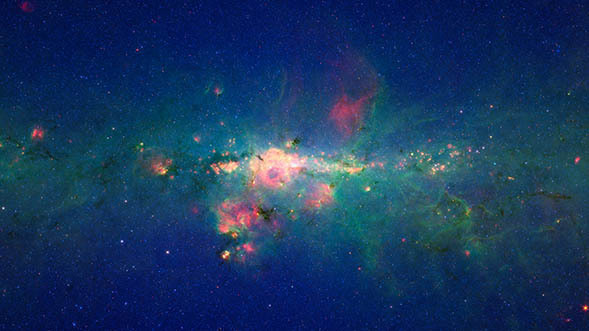
NASA's Spitzer Space Telescope builds on a solid scientific and technical foundation established by two previous space infrared satellites. Both of these missions demonstrated the fundamental cryogenic technology and the considerable scientific benefit of liquid-helium-cooled telescopes and instruments in space.
The InfraRed Astronomical Satellite (IRAS), a NASA Explorer mission, conducted the first survey of the sky at thermal infrared wavelengths in 1983. A collaborative effort between the US, the Netherlands and the UK, IRAS opened a new chapter in astronomical exploration. Utilizing a 57-cm diameter telescope cryogenically cooled to a temperature of 4 K, IRAS circled the Earth in a 900-km polar orbit and operated for 10 months before its liquid helium was exhausted.
Ninety-six percent of the sky was mapped in four broad wavelength bands, centered at 12, 25, 60 and 100 microns. The hundreds of thousands of infrared sources detected by IRAS doubled the number of sources cataloged by astronomers. In the two decades since this path-breaking mission, scientists have published thousands of papers based on IRAS data, establishing the framework for all subsequent infrared observatories.
IRAS discovered disks of dust circling nearby stars, now thought to be an evolutionary step in the formation of planetary systems. The satellite also noted the presence of "infrared cirrus," or dust grains, throughout the Milky Way Galaxy. IRAS identified a class of "starburst" galaxies, whose luminosity is due primarily to the birth of countless young and massive stars. The familiar winter constellation of Orion presents a spectacular contrast between the visible-light view (left) and the appearance as seen by IRAS (right).
The Infrared Space Observatory (ISO), a cornerstone European Space Agency mission, was launched in late 1995. ISO employed a suite of four scientific instruments to study the cosmos at wavelengths extending from 2.5 to 240 microns. Employing a cryogenic 60-cm diameter telescope and the first infrared detector arrays in space, ISO provided astronomers with a significant improvement in capabilities. Operating in a highly elliptical orbit, ISO circled the Earth once a day during its 30-month mission. Unlike IRAS, the ISO satellite was used primarily to observe individual targets, conducting 28,000 separate observations.
While the satellite no longer functions, ISO archival research continues to this day. Among the most important of the ISO findings is the discovery that water is abundant throughout the Galaxy. Its unprecedented spectroscopic capabilities allowed ISO to discover and characterize many new interstellar molecules. Moreover, ISO confirmed and extended many of the IRAS discoveries, including the existence of planet-forming circumstellar dust disks.
Other airborne (Kuiper Airborne Observatory and the Stratospheric Observatory for Infrared Astronomy or SOFIA) and space-based experiments (COBE/FIRAS, IRTS, MSX, Akari, Herschel, Planck) have made important contributions to the field of infrared astronomy research. Spitzer provided order-of-magnitude improvements in astronomical capabilities beyond previous observatories.
Spitzer went well beyond the scope of any previous cryogenic infrared space mission by making extensive use -- for both imaging and spectroscopy -- of the large-format infrared detector arrays. Many of Spitzer's observations will be used as a guide for more detailed studies by NASA's James Webb Space Telescope.



